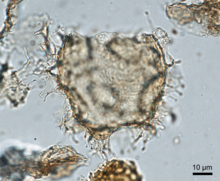Palynodinium (original) (raw)
From Wikipedia, the free encyclopedia
Extinct genus of dinoflagellate cysts
| Palynodinium | |
|---|---|
 |
|
| Bright-field photomicrograph of Palynodinium grallator produced by Sandy McLachlan, University of Victoria from the Oyster Bay Formation of eastern Vancouver Island. | |
| Scientific classification |
|
| Domain: | Eukaryota |
| Clade: | Diaphoretickes |
| Clade: | SAR |
| Clade: | Alveolata |
| Phylum: | Myzozoa |
| Superclass: | Dinoflagellata |
| Class: | Dinophyceae |
| Order: | Gonyaulacales |
| Family: | †Areoligeraceae |
| Genus: | †_Palynodinium_H.Gocht, 1970 |
Palynodinium is an extinct genus of organic-walled dinoflagellate cyst (or dinocyst). It is a fossil species of dinoflagellate cyst used to demarcate the K/Pg boundary, which marks the terminal Cretaceous and the extinction of the dinosaurs.[1] Palynodinium grallator was among the microfossils which lead to the recent discovery of the K/Pg event record in marine sediments of the northeast Pacific.
Dinoflagellate cysts are estimated to be produced by 10–16% of living dinoflagellates[2][3] as a dormant, zygotic stage of their life cycle, which can accumulate in marine sediments as microfossils. Organic-walled dinoflagellate cysts are noted for their resistance to degradation owing to their composition of dinosporin, a biopolymer similar to sporopolinin characteristic of many terrestrial palynomorphs.[4][5] Their abundance, cosmopolitan distribution, and quality of preservation in the fossil record since the Middle Triassic[6][7] make dinoflagellate cysts excellent indicators of primary productivity[8][9] as well as tools for biostratigraphy and paleoenvironmental reconstructions.[10][11] The scope of dinoflagellate cyst applications has resulted in ongoing collaborative efforts between industry and academia to refine their taxonomic classification[12] and enhance their utility through database organization.[13]
- ^ Beaudoin, Alwynne Bowyer; Head, M. J.; Head, Martin J. (2004). The Palynology and Micropalaeontology of Boundaries. p. 261. ISBN 9781862391604.
- ^ Head, M.J., 1996. Modern dinoflagellate cysts and their biological affinities, in: Jansonius, J., McGregor, D.C. (Eds.), Palynology: Principles and Applications. Association of Stratigraphic Palynologists Foundation, pp. 1197–1248.
- ^ Askin, Rosemary A.; Jacobson, Stephen R. (1 January 2003), "Palynology", in Meyers, Robert A. (ed.), Encyclopedia of Physical Science and Technology (Third Edition), New York: Academic Press, pp. 563–578, ISBN 978-0-12-227410-7, retrieved 8 May 2022
- ^ Fensome, R.A., Taylor, F.J.R., Norris, G., Sarjeant, W. A. S., Wharton, D.I., Williams, G.L., 1993. A classification of fossil and living dinoflagellates. Micropaleontol. Press Spec. Pap. 7, 1–351.
- ^ Bogus, K., Mertens, K.N., Lauwaert, J., Harding, I.C., Vrielinck, H., Zonneveld, K.A.F., Versteegh, G.J.M., 2014. Differences in the chemical composition of organic-walled dinoflagellate resting cysts from phototrophic and heterotrophic dinoflagellates. J. Phycol. 50, 254–266.
- ^ Fensome, R.A., MacRae, J.M., Moldowan, F.J.R., Williams, G.L., 1996. The early Mesozoic radiation of dinoflagellates. Paleobiology 22, 329–338.
- ^ Riding, J.B., Mantle, D.J., Backhouse, J., 2010. A review of the chronostratigraphical ages of Middle Triassic to Late Jurassic dinoflagellate cyst biozones of the North West Shelf of Australia. Rev. Palaeobot. Palynol. 162, 543–575.
- ^ Dale, B., 1996. Dinoflagellate cyst ecology: Modeling and geological applications, in: McGregor, J.J.& D.C. (Ed.), Palynology: Principles and Applications. American Association of Stratigraphic Palynologists Foundation, Dallas, pp. 1249–1276.
- ^ Pospelova, V., de Vernal, A., Pedersen, T.F., 2008. Distribution of dinoflagellate cysts in surface sediments from the northeastern Pacific Ocean (43-25°N) in relation to sea-surface temperature, salinity, productivity, and coastal upwelling. Mar. Micropaleontol. 68, 21–48.
- ^ Stover, L.E., Brinkhuis, H., Damassa, S.P., Verteuil, L. De, Helby, R.J., Monteil, E., Partridge, A.D., Powell, A.J., Riding, J.B., Sllleiror, M., Williallls, G.L., 1996. Mesozoic–Tertiary dinoflagellates, acritarchs, and prasinophytes, in: Palynology: Principles and Applications. Association of Stratigraphic Palynologists Foundation, Dallas, pp. 641–750.
- ^ Bowman, V.C., Francis, J.E., Riding, J.B., 2013. Late Cretaceous winter sea ice in Antarctica? Geology 41, 1227–1230.
- ^ Williams GL, Fensome R, MacRae RA. 2017. DINOFLAJ3. American Association of Stratigraphic Palynologists, Data Series No 2.http://dinoflaj.smu.ca/dinoflaj3/index.php/Palynodinium_grallator
- ^ Bijl, Peter K. (2022). "DINOSTRAT: A global database of the stratigraphic and paleolatitudinal distribution of Mesozoic–Cenozoic organic-walled dinoflagellate cysts". Earth System Science Data. 14 (2): 579–617. Bibcode:2022ESSD...14..579B. doi:10.5194/essd-14-579-2022. S2CID 246746360.